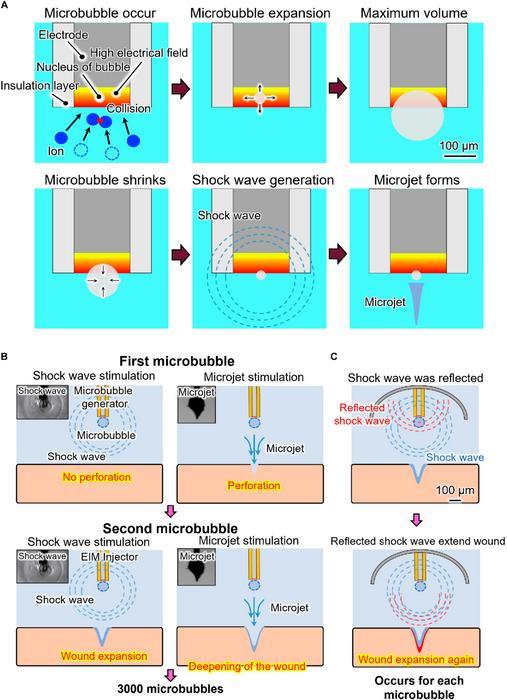A pioneering advancement in the realm of medical technology has emerged from researchers at Kyushu University, who have devised an innovative needle-free injection system that harnesses the power of microbubble dynamics and shock wave reflection. This groundbreaking technique offers a transformative alternative to traditional syringe-based drug delivery, aiming to surmount long-standing challenges related to infection risks and patient discomfort typically associated with needle injections. By exploiting the physical behavior of electrically induced microbubbles, the researchers have markedly enhanced the depth and efficacy of reagent injection, setting a new benchmark for needle-free administration methods.
At the heart of this revolutionary method lies the formation and dynamic behavior of electrically induced microbubbles at the tip of an electrode, which is energized by precise voltage pulses. When a high-voltage electric field concentrates at the electrode apex, microbubbles rapidly nucleate and oscillate. This pulsating activity creates powerful shock waves and microjets during the microbubble’s collapse phase. These physical phenomena collectively perforate tissue surfaces and facilitate the insertion of reagents without the physical trauma typically associated with needle penetration. Unlike traditional needle-free injectors, this electrically driven microbubble generator boasts simplicity, cost-effectiveness, and seamless integration potential with existing medical devices.
The injection mechanism operates in a cyclic fashion wherein each voltage pulse initiates a sequence of microbubble generation, expansion, contraction, and shock wave emission. Initially, the shock wave induces tissue vibration without causing damage. Subsequently, the microjet that forms punctures the tissue, initiating a controlled permeation. Repeated pulses then propagate this effect, enlarging and deepening micro-perforations through tissue vibration induced by successive shock waves. The research team conducted up to 3,000 such cycles to ensure effective tissue injection, reflecting meticulous control over the dynamic process and ensuring reproducibility.
A novel aspect of this study lies in the implementation of a semi-ellipsoid reflector strategically designed to capture and redirect the shock wave energy that would otherwise dissipate away from the target tissue. Ordinarily, shock waves emanate isotropically—spreading in all directions after microbubble collapse—resulting in substantial mechanical energy loss. By introducing a reflector, the researchers successfully harnessed the shock waves directed away from the tissue and reflected them back toward the treatment site. This feedback mechanism amplifies tissue perforation and reagent introduction capabilities, enhancing overall injection depth and accuracy while optimizing energy efficiency.
To validate their approach, the team compared injection depths achieved with and without the shock wave reflection apparatus. Utilizing advanced imaging techniques such as schlieren photography, the study visually captured and analyzed shock wave propagation and reflection patterns. The results demonstrated an approximate 200-micrometer increase in reagent penetration depth when employing the reflector, a significant improvement with potential clinical relevance in ensuring precise drug delivery. This validation underscores the method’s promise in achieving deeper, more uniform injections without necessitating intrusive needles.
The practical implications of this development extend beyond mere injection depth. The device’s operational simplicity, which stems from the electrical induction of microbubbles rather than mechanical or hydraulic means, renders it highly adaptable for various medical settings. Moreover, its low production cost facilitates scalability and widespread adoption, particularly crucial for resource-limited environments where safe and effective injection modalities are desperately needed. This electrical microbubble technology thus stands at the nexus of innovation, safety, and accessibility.
From a biomechanical perspective, the pulsatile dynamics and cumulative effect of shock waves on tissue integrity offer intriguing insights into controlled tissue permeabilization. The repeated mechanical oscillation induced by microbubble activity leads to microjet formation, which perforates tissues with minimal invasiveness. Subsequent shock wave reflections not only expand these micro-perforations but also stimulate tissue vibration that may augment reagent diffusion. This interplay of physical forces illustrates a sophisticated union of physics and biology, enabling precise modulation of tissue disruption and therapeutic delivery.
Looking forward, the authors emphasize ongoing efforts to refine the shock wave reflection mechanism. Enhancing the reflector’s geometry and material composition could focus shock waves more precisely, further increasing injection efficiency and reducing potential tissue trauma. Such optimization holds promise for tailoring this needle-free technology to a broad spectrum of applications ranging from vaccine administration to localized drug delivery for chronic conditions. Additionally, integrating feedback sensors or automation could elevate device functionality, promoting personalized and adaptive treatment regimes.
The research team, including Yibo Ma, Wenjing Huang, Naotomo Tottori, and Yoko Yamanishi, contributed expertise in engineering, biomedical sciences, and physics to this multifaceted innovation. Their interdisciplinary collaboration is emblematic of the convergent approaches required to tackle complex biomedical challenges. Supported by notable grants from JSPS KAKENHI, JST CREST, JST Moonshot R&D, and JST SPRING, this study reflects substantial institutional backing, underscoring its scientific and translational potential.
Published in the journal Cyborg and Bionic Systems on March 19, 2025, under the title “Development of Repetitive Mechanical Oscillation Needle-Free Injection through Electrically Induced Microbubbles,” the paper not only delineates the experimental framework but also charts a visionary path toward revolutionizing drug delivery systems. The journal, renowned for spotlighting innovations at the intersection of robotics and biomedical engineering, provides an apt platform for disseminating these findings to the wider scientific community.
In summary, the Kyushu University team’s needle-free injection system represents a significant leap forward, marrying the subtle dynamics of electrically induced microbubbles and shock wave physics to surmount longstanding challenges in medical injections. This technology promises safer, less painful, and more efficient drug delivery while mitigating infectious risks associated with traditional needles. As optimization efforts continue, this platform’s versatility and scalability position it as a compelling candidate for next-generation healthcare solutions worldwide.
Subject of Research: Needle-free drug injection technology based on electrically induced microbubble dynamics and shock wave reflection
Article Title: Development of Repetitive Mechanical Oscillation Needle-Free Injection through Electrically Induced Microbubbles
News Publication Date: March 19, 2025
Web References: DOI: 10.34133/cbsystems.0225
Image Credits: Yibo Ma, Kyushu University
Keywords: Applied sciences and engineering, Health and medicine, Life sciences
Tags: advancements in medical technologyalternatives to syringe-based drug deliveryelectrically induced microbubblesinnovative drug delivery systemsmechanical oscillation in injectionsmicrobubble dynamicsneedle-free injection technologyovercoming needle reuse challengespatient comfort in injectionsreducing infection risks in healthcaresafe drug administration methodstransformative healthcare solutions





